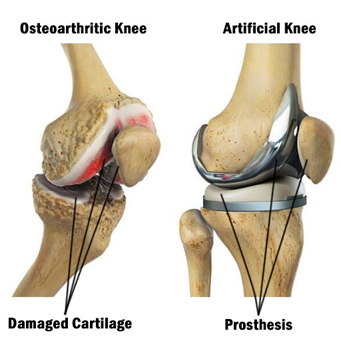
Hey Doc! Can you save my arthritic Knee from Total Knee Replacement?
Being a volume Joint Replacement Surgeon (doing massive number of Joint Replacement), in Delhi, and following Best Practices, I come across this question quite often. Undoubtedly, any surgeon, would advise Total Knee replacement to a patient who has end stage degeneration of Knee.
Is there still a way out that we can avoid TOTAL Knee replacement, in a person who has complete loss of articular cartilage in Knee? The answer is YES!!!! In selected cases, we can do a very small surgery of PARTIAL Knee Replacement (or Unicondylar Knee Replacement). Partial Knee replacement or Unicondylar Knee Replacement is a surgery of much much lesser magnitude, with very very quick recovery as compared to Total Knee Replacement.
To understand the whole story, we need to understand the following four scientific facts:
- 1. What actually is Knee Replacement?
- 2. How do we assess cartilage damage In an X-ray?
- 3. Who are the candidates for Partial Knee Replacement?
- 4. What are the benefits of Partial Knee Replacement?
What exactly is Knee Replacement?
Knee Replacement, in fact is a misnomer term. People carry an impression that their knee joint as a whole will be discarded and a new knee will be implanted. In Knee Replacement we do not replace the knee as a whole. We actually replace the cartilage which is damaged and worn out. So, in actuality, knee replacement is nothing but knee resurfacing. We resurface the end of the bones which form the knee joint, namely Thigh bone (Femur), Shin bone (Tibia) and Knee cap (Patella). See the pic below:

How do we assess cartilage damage In an X-ray?
If you compare the two X-Rays given below on the left side you find some space between the two bones, and on the right you find that the bones are touching each other. The space visible between the two bones, visible on an x-ray is actually the so-called joint space or the space occupied by the cartilage. Space represents amount of cartilage!!!!! If there is adequate space, there is adequate amount of cartilage if there is no space (as in on the right), then there is no cartilage. It is as simple!!!! And the height of the space between the two bones, proportionally, indicates the amount of cartilage available in the joint.

What is Unicondylar/ Partial Knee Replacement?
If you compare the two pictures given below, on the left it shows loss of space throughout the knee on the right it shows loss of space only in confined area of the knee. In the right-side picture, the loss of cartilage is confined to inner part of the knee, or also called as medial tibio-femoral joint. So, in selected patients with the kind of picture as shown on the right side, one can think of performing Partial Knee Replacement. Fortunately, large number of cases in our country, are eligible for Partial Knee Replacement or Unicondylar Knee Replacement. Do ask your doctor if you are a candidate for Partial Knee Replacement, if you have been advised Total Knee Replacement. Remember only your surgeon can decide this, not you!!!!


What are the advantages of Unicondylar/ Partial Knee Replacement?
As I have said it earlier, Partial Knee Replacement is a quick and small surgery but requires lot of expertise to perform. Surgery takes about 30 minutes with practically no blood loss. The rehabilitation is usually quick and the patient is up and about within few hours and can walk without support within few days. Patient can assume office in 3 to 4 weeks. Majority of patients start driving in 3 weeks or so. Patient starts feeling almost normal in 6 weeks. Biggest advantage is that you are permitted to sit cross legged and permitted to squat. In India, there is a large number of patients suffering from knee pain and end stage arthritis, whose livelihood depends on sitting cross legged or on floor, like a Gardner. Such type of patients can be immensely benefitted by a partial Knee Replacement Surgery.





